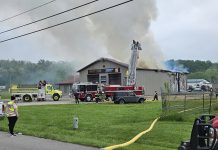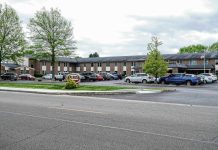It’s day five of the new year, and Columbus Mayor Jim Lienhoop already is looking beyond 2020.
The city’s chief executive was sworn in Wednesday to a second term, having run unopposed in the November general election after defeating Republican challenger Glenn Petri in the May primary.
With four years of experience, Lienhoop said he is ready to tackle the full plate of significant projects ahead.
In his first four-year term, Lienhoop said his administration has been able to address some of the most significant challenges that the city has faced in recent years, alluding to the traffic delays on the city’s west side caused by increased railroad traffic and the city’s efforts to address substance use disorder.
[sc:text-divider text-divider-title=”Story continues below gallery” ]Click here to purchase photos from this gallery
In November, the city broke ground on the long-awaited railroad overpass over the State Road 46 and State Road 11 crossing. At the Nov. 4 groundbreaking ceremony, Lienhoop said a railroad overpass was goal No. 1B of his first term.
“The railroad project is underway, and it will have an ending,” Lienhoop said. “There will be a ribbon cutting and we’ll be able to drive over the new entryway into town.”
Goal No. 1A? Establishing ASAP, the Alliance for Substance Abuse Progress.
Lienhoop said he senses that the substance abuse issue is going to exist for a “long, long time.” With ASAP established, Lienhoop said the goal now is to make sure the program remains well-funded, well-staffed and well-led.
“I’m hopeful that (four years from now), ASAP will have been extraordinarily successful in changing people’s lives, not only those who have fallen to addiction but also the folks in the community who are affected by that, be that the family members, friends or citizens,” he said. “I’m hopeful that ASAP makes progress in that.”
Other projects completed in 2019 include State Street Phase 1, which connects the East Columbus Neighborhood to downtown Columbus through a more welcoming, walkable pathway. In 2020, the focus will shift to the extension of State Street improvements to California Street up to Fifth Street, the mayor said.
Lienhoop said he’s also pleased with the development of Evolution, the public safety training facility that opened in November, and the city employee salary study, which has been completed and two-thirds implemented.
The new training facility, located in the Columbus Air Park, offers a training experience unlike what Columbus has ever previously offered. Lienhoop said because the demand among the public for first responders continues to increase, a facility where public safety officials can get the best training possible is necessary.
The salary study is something Lienhoop said he asked for during his term on Columbus City Council six years ago. The study, completed by McCordsville-based firm Total Reward Solutions, presents an improved compensation arrangement to Columbus city employees across the spectrum.
“(City employees) really do perform a significant amount and broad array of services,” Lienhoop said. “At the city, we land airplanes and pick up puppy dogs among other things. The variety of things we do is kind of overwhelming at times, and we need people who are qualified in those areas and we need to pay them fairly.”
As the Lienhoop administration advances into 2020 and beyond, Lienhoop wants to see the city’s significant projects come to fruition, including the hotel conference center — a significant piece of Envision Columbus, the downtown Columbus strategic development plan — the riverfront redevelopment and the railroad overpass.
Two items on his agenda that Lienhoop said were recognized four years ago but still need more work today are housing supply and economic diversification.
Lienhoop said Columbus needs more residential units at all price points to meet market demand. Second, while he noted that the city’s economy is robust, “we’ve got a lot of eggs but too few baskets.”
“We’re heavily dependent upon diesel engines and automotive supply,” Lienhoop said. “We need to continue to pursue diversification efforts and part of that will be trying to find land that developers want to convert to industrial use.”
Examples of industries Lienhoop would like to continue to attract to Columbus include manufacturing, assembly and research and development. Currently, Lienhoop said the Greater Columbus Economic Development Corp. promotes Columbus through direct calls to companies and trade organizations that might have an interest in expanding to Columbus.
“It’s a slow process but one that you have to do if you expect to grow,” Lienhoop said.
The start of the new year, and new term, is a perfect time, he said, to remind people that city leaders do listen and do try to take into account the opinions they receive, the mayor said.
What the administration is trying to do is build the community for the next 20 to 30 years.
Lienhoop said there are two states — growth and decay. Columbus wants to grow.
“How do we do that? Part of what we have to do and part of what the Envision Columbus plan was oriented toward is, ‘What’s it going to take for the city of Columbus to continue to be an extraordinary place 20 years from now?’” Lienhoop said.
“We need better housing. We need a few amenities that we don’t have today. People have changed. What their desires are today are different than what they were 50 years ago.”
Lienhoop said part of the reason city leaders are making the decisions that they’re making, whether it’s at FairOaks Mall or the riverfront, is in response to what residents want to see in a community.
“We’re trying to be responsive to what particularly young people want to see in a community so that 20 or 30 years from now, we’ll still be a desirable place,” he said. “Columbus is a great place. Indiana is a great place. But you’ve got to broaden your horizon. You’ve got to be able to look at other communities, not only in the U.S. but elsewhere.”
Columbus isn’t the first city to repurpose a mall or redevelop a riverfront to make it an attraction for residents and tourists. Oftentimes, however, Lienhoop said you don’t know it’s not unique until someone from outside comes in and tries to help understand what people are looking for and what other communities have done — what works and what doesn’t work.
“We’ve got a great community with a bright future, and I’m really excited about what the opportunities are during the next four years,” Lienhoop said.
[sc:pullout-title pullout-title=”Lienhoop’s to-do list” ][sc:pullout-text-begin]
Looking ahead to 2020 and beyond, here’s what Columbus Mayor Jim Lienhoop hopes to accomplish during his second four-year term.
- Complete the railroad overpass over the State Road 46 and State Road 11 intersection.
- Extend State Street improvements to California and Fifth streets.
- Continue to support the Alliance for Substance Abuse Progress in its recovery and substance abuse prevention efforts.
- Fully implement a three-year salary study for city employees.
- Maintain a fully-staffed police department.
- Complete the development of a proposed hotel conference center in downtown Columbus.
- Complete the redevelopment of the city’s riverfront.
- Add more residential units at all price points to Columbus.
- Pursue economic diversification efforts to attract more industries to Columbus.
- Make progress on the redevelopment of FairOaks Mall and Donner Center.
[sc:pullout-text-end]





